With the rising demand for quick and convenient food delivery services, apps like Jahez have become a go-to solution across many regions—especially in the Middle East.
Jahez stands as a prominent player in the Saudi food delivery industry with the stats as shown in the infographic below.
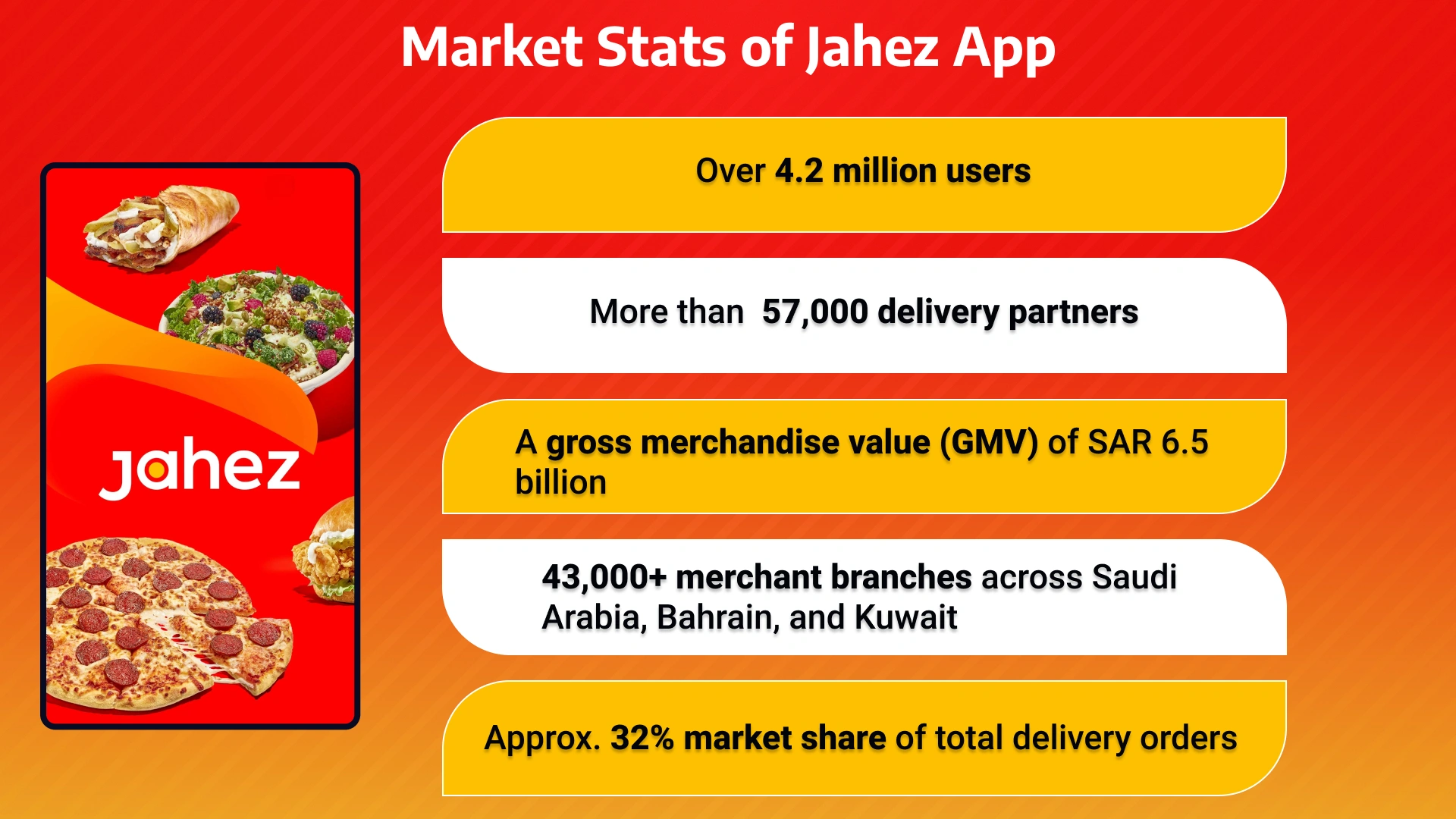
Whether you're a food delivery startup or a restaurant chain planning to digitize their business, creating an app like Jahez can unlock significant growth opportunities.
But before jumping into development, the first question to answer is: how much does it cost to develop an app like Jahez in KSA?
The average cost to build a food delivery app like Jahez in Saudi Arabia ranges between SAR 200,000 and SAR 1,955,000+($50,000-$580,000+). However, the actual cost depends on various factors such as app features and complexity, choice of platform, technology stack, and developer expertise location.
In this blog, we’ll break down all the major cost-driving factors to help you plan your investment smartly and strategically.
Let’s start with a brief intro about the Jahez app:
Jahez App: How It Works and Why It's Different from Other Food Delivery Apps
A few years ago, Jahez entered Saudi Arabia’s food delivery market—fast, local, and made for Saudis. Unlike global players like Uber Eats or regional competitors like HungerStation and Jahez built its platform with a focus on local culture, customer preferences, and affordability.
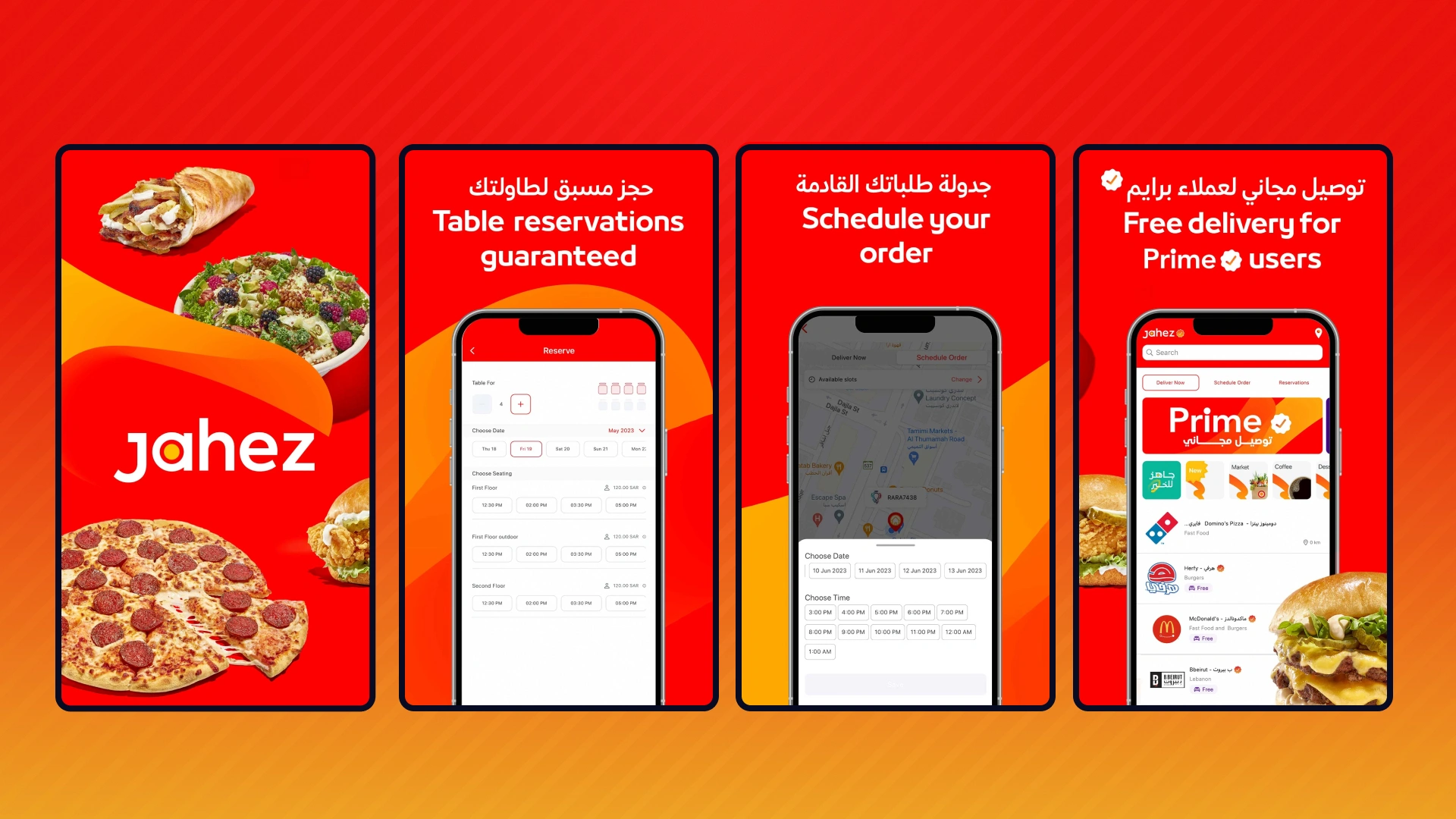
How does the Jahez Food Delivery App in KSA work? Jahez Business Models
At its core, Jahez operates on a three-sided marketplace model that seamlessly connects customers, restaurants, and delivery partners. The app earns revenue through:
- Commissions from restaurants for each order
- Delivery fees collected from customers
- Premium subscription plans offering exclusive perks
- Sponsored listings and in-app ads from restaurant partners
What truly sets Jahez apart is its strategy—not just what the app does, but how it does it. While competitors invested $500K to $ 1 M+ in cost to build an app like Hungerstation, Jahez prioritized efficiency and cultural alignment.
If you're wondering about the cost to develop a food delivery app like Jahez, the answer lies not only in the technology stack but also in understanding the market you're building for.
What Makes Jahez Different from Other Competitors in Saudi Arabia?
Here are several key differentiators from competitors:
- Faster Delivery in Tier-1 Cities: Due to strong local logistics partnerships.
- Better Restaurant Onboarding: Focused on onboarding small, local vendors.
- Ramadan & Cultural Adaptability: Special UX/UI for peak order times during Iftar and Suhoor.
- Full Arabic Language Support: Including regional dialects, making the app feel native to users from different parts of KSA.
- Preferred Payment Methods: Jahez supports Mada, SADAD, and cash-on-delivery, aligning with popular payment preferences in the region.
- Halal & Religious Sensitivity: Built-in halal filters and order suspensions during prayer times show a deep respect for religious practices.
Today, Jahez isn’t just delivering meals; it's inspiring startups across the Middle East. Its success is a blueprint for anyone looking to build a localized, culturally intelligent platform in the Middle East.
If you're exploring the cost to develop a food delivery app like Jahez, remember: it's not just about budget or code—it's about understanding your audience better than anyone else.
How Much Does it Cost to Develop an App Like Jahez in Saudi Arabia?
The cost of on-demand food delivery app development like Jahez in KSA, Saudi Arabia, typically falls between SAR 200,000 and SAR 1,955,000+($50,000-$580,000+). It includes factors that influence the cost to create an on-demand food delivery app such as design complexity, features and development team location.
Here’s a breakdown of the estimated cost and timelines for building an app like Jahez, categorized by different levels of complexity:
| App Types | Estimated Cost | Key Features | Estimated Timelines |
| Basic Food Delivery App | SAR 38,500 - SAR 150,500 ($45,000-$75,000) |
| Approx. 3 to 6 months |
| Moderate Complex Food Delivery App | SAR 150,500- SAR 400,300 ($75,000-$200,300) |
| Approx. 6 to 8 months |
| Advanced Food Delivery App | SAR 400,300 - SAR 1,100,200+ ($300,200-$500,200+) |
| Approx. 9 to 12+ months |
Based on the hiring location of your mobile app development company and the required features, you can easily calculate the Jahez like on-demand food delivery app cost in Saudi with the formula.
Total Development Cost = Hourly Rate x Development Time
The average cost of food delivery apps in Saudi Arabia can range from SAR 200,000 and SAR 1,955,000+($50,000-$580,000+). To build an app like Jahez in KSA, careful planning and clear definitions of requirements are essential for cost estimation and successful project execution.
Factors That Impact On-Demand Food Delivery App Development Cost
Creating an app like Jahez in KSA involves several factors which contributes to the overall cost to build a successful mobile app for food industry. Let’s break down the most influential factors one by one:

Design Complexity
The design of your app plays a critical role in both user engagement and development cost. A simple, minimalist design with standard UI elements will be more affordable.
However, if you want custom UI/UX design with animations, micro-interactions, and user-friendly flows tailored to different user roles (customer, delivery agent, admin), the cost increases.
Here’s a breakdown of the cost to develop a food delivery app like Jahez, along with design complexity:
| Design Complexity | Estimated Costs |
| Basic Design | SAR 18,750 – SAR 30,000 ($5,000 – $8,000) |
| Advanced ui/ux Design | SAR 37,500 – SAR 75,000 ($10,000 – $20,000) |
Multiple Platform Support
Building for Android, iOS, and web multiplies on-demand food delivery app development cost and time. A cross-platform framework like Flutter can reduce duplication and time but still requires effort for optimization.
Below is a breakdown of the cost to develop a food delivery app like Jahez in KSA based on multiple platform support:
Platform Levels | Estimated Cost Range |
Simple Platform (Whether Android or iOS) | SAR 56,250 – SAR 93,750 ($15,000 – $25,000) |
Cross-Platform | SAR 112,500 – SAR 187,500 ($30,000 – $50,000) |
Web Platform | SAR +37,500 – SAR 75,000 (+$10,000 – $20,000) |
Development Team Location
Hourly rate of your dedicated development team heavily impacts your budget. Jahez app development cost varies by region. Hiring mobile app development in Saudi Arabia or the U.S. costs more, while offshore teams from Asia or Eastern Europe are more budget friendly.
Hire remote mobile app developers in the US, Canada, or Western Europe typically charge $100–$200 per hour, which means a project requiring 1,000 hours could cost around $150,000.
On the other hand, experienced developers in regions like India or Southeast Asia may charge $20–$50/hour, bringing the total cost down to $30,000–$50,000 for the same scope.
Choosing a region with quality talent at a competitive rate can optimize your spending without compromising quality.
Hiring Models (In-house and Outsourcing)
Selecting the right business model between in-house development and outsourcing influences the cost to develop a food delivery app like Jahez in KSA. In-house teams offer more control but cost more due to salaries, infrastructure, and benefits. Outsourcing to a trusted iOS mobile app development company can cut costs by up to 40%.
- In-house: SAR 450,000–700,000 ($120,000–$187,000)
- Outsourcing: SAR 250,000–400,000 ($67,000–$107,000)
Businesses should choose a hiring model that balances budget, timeline, and quality.
Security Measures
Another factor that significantly impacts the restaurant delivery app development pricing in KSA is security measures. Implementing robust security features adds both development time and technology expenses.
Still, it is essential for user trust and regulatory compliance—especially in regions like Saudi Arabia with strict data laws.
Here’s how security influence the cost to develop a food delivery app like Jahez:
- Advanced Encryption & SSL: Adds cost for licensing and secure data transmission.
- Secure Payment Gateway Integration: PCI-DSS compliant solutions may involve higher integration costs.
- Authentication Systems (2FA, OAuth): Require extra development time and third-party services.
- Regular Security Audits: Hiring cybersecurity experts or external vendors increase operational costs.
- Compliance with Local Regulations: Adapting to Saudi data protection laws like SDAIA may require legal and technical consultation.
- Data Backup & Disaster Recovery: Needs additional cloud storage and services.
Investing in strong security not only protects your app but also reduces long-term risks of data breaches and legal penalties.
Technology Stack
One of the most important factors that influence the overall cost to develop a food delivery app like Jahez in Saudi Arabia is the tech stack. The choice of technologies directly affects development span, licensing fees, scalability, security, and developer accessibility--all of which contribute to the final budget.
Now, a query pops up in your mind: How do tech stacks affect app development cost?
Cross-platform vs Native Development
- Cross-platform (Flutter/React Native): Saves cost (single codebase for iOS & Android).
- Native (Swift for iOS, Kotlin for Android): Higher cost due to separate development.
Backend Stack Choice
- Node.js/Python (open-source): Cost-effective with a large talent pool.
- Java/.NET (enterprise-grade): More secure but may increase licensing and development costs.
Database & Hosting Services
- Cloud solutions (AWS, Azure): Scalable and reliable, but with ongoing operational costs.
- Self-hosted options: Lower recurring cost, but higher upfront infrastructure setup.
Third-Party APIs & Tools
- Google Maps, Twilio, HyperPay: Improve functionality but add per-usage fees.
Here is a breakdown of the on-demand food delivery app development cost:
- Basic tech stack (open-source, cross-platform): SAR 250,000–350,000 ($67,000–$93,000)
- Advanced tech stack (native apps, enterprise backend): SAR 450,000–700,000 ($120,000–$187,000)
The more advanced and scalable technology you use to build a food delivery app in KSA. The higher your initial development cost—but it often results in better performance, security, and long-term savings.
Third-Party Integration
Third-party integrations can streamline features and reduce development time, but they also add licensing, subscription, and integration costs.
Below is a cost breakdown for food delivery app development like Jahez in KSA, Saudi Arabia, based on integration types:
| Integration Type | Examples (Popular in KSA) | Cost Impact (SAR) |
| Payment Gateways | HyperPay, PayTabs, STC Pay | SAR 10,000–30,000 |
| Maps & Routing | Google Maps, HERE Maps | SAR 5,000–15,000 (usage-based) |
| SMS & Notifications | Twilio, OneSignal, Firebase | SAR 2,000–8,000 monthly |
| Chat & Support | Zendesk, SendBird, Freshchat | SAR 8,000–20,000 |
| Analytics Tools | Google Analytics, Mixpanel | SAR 2,000–10,000 |
Feature Complexity
Feature complexity scales cost to develop a food delivery app like Jahez with each additional custom module, AI capability, or real-time component. The more custom and complex features mean the higher development expenses:
Here are Jahez like app features and costs in Saudi Arabia:
| Feature | Complexity Level | Estimated Cost Impact (SAR) |
| Basic Order & Menu Management | Low | SAR 30,000–50,000 |
| Real-Time Order Tracking | Medium | SAR 40,000–70,000 |
| Multi-language & Currency Support | Medium | SAR 20,000–40,000 |
| AI-based Search & Recommendations | High | SAR 60,000–100,000 |
| Dynamic Pricing, Coupons, Loyalty | Medium-High | SAR 50,000–80,000 |
| Admin & Vendor Dashboards Medium | Medium | 30,000–60,000 |
Must-Have Features of an On-Demand Food Delivery App Like Jahez
To build a successful on-demand food delivery app like Jahez in KSA, it’s essential to incorporate a complete set of features tailored for users, restaurants, delivery personnel, and admins.
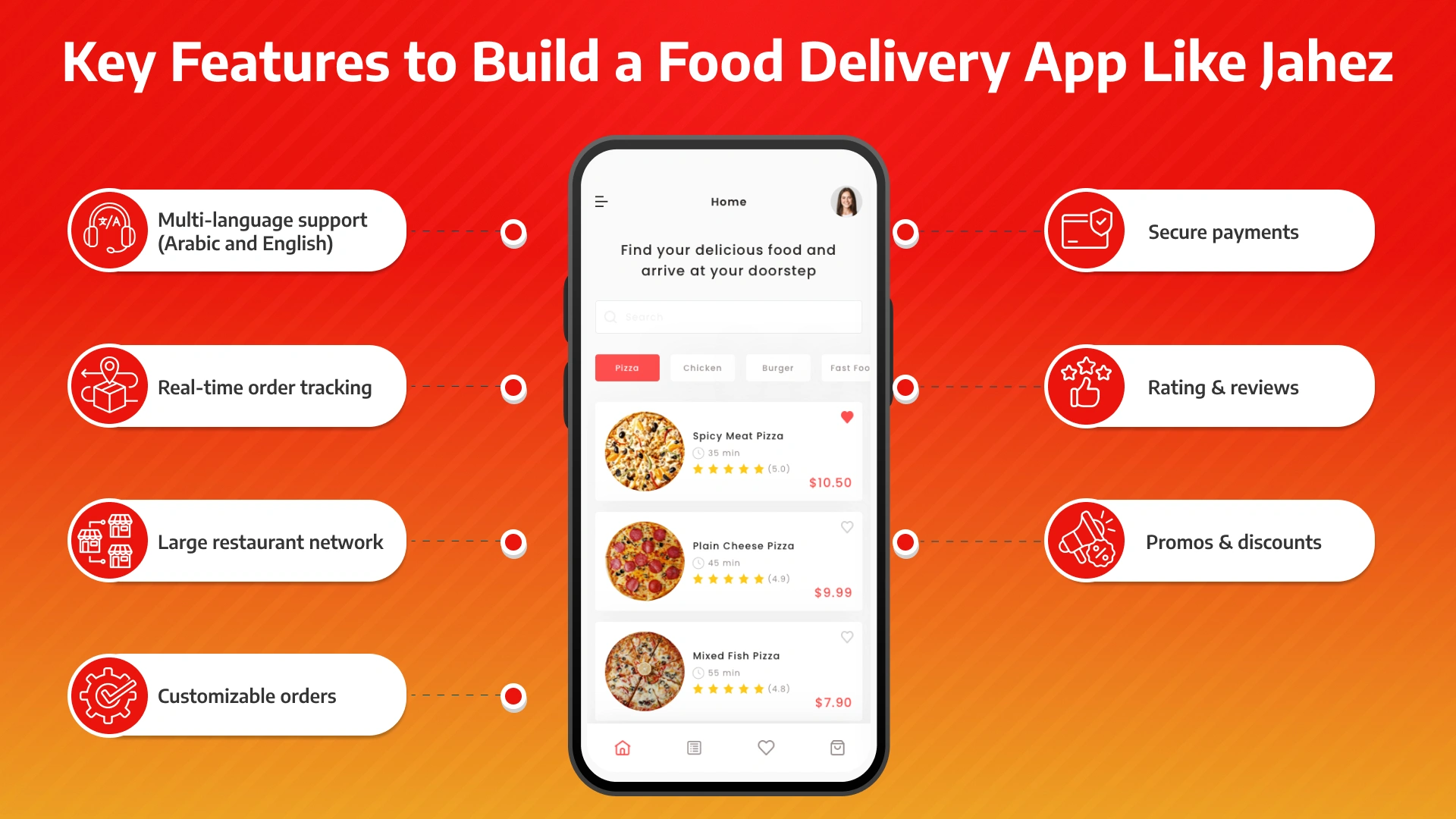
These features not only ensure smooth functionality but also enhance user satisfaction, restaurant engagement, and operational efficiency, which directly influence restaurant app development in Saudi Arabia's pricing.
1. User-Side Features
The end-users are the heart of any food delivery app. These features ensure a seamless, secure, and satisfying ordering experience.
- User Registration & Profile Management – Easy sign-up via email, phone number, or social media.
- Restaurant Listings – Categorized by cuisine, ratings, distance, etc.
- Advanced Search & Filters – To find dishes or restaurants quickly.
- Real-Time Order Tracking – Track order status and delivery partner’s location live.
- Multiple Payment Options – Support for Mada, Apple Pay, credit cards, and cash on delivery.
- Order History & Reordering – Check previous orders and reorder them again with just a single click.
- Ratings & Reviews – Provide feedback on restaurants and the delivery experience.
- Promo Codes & Loyalty Rewards – Encourage repeated orders with discounts.
- In-App Chat & Support – Resolve order issues directly from the app.
2. Restaurant-Side Features
Restaurants need powerful tools to manage incoming orders, menus, and customer preferences.
- Restaurant Dashboard – Overview of all current, past, and pending orders.
- Menu Management – Add, update, or remove items with pricing and availability.
- Order Notifications – Instant alerts for new orders via app or email.
- Order Acceptance & Scheduling – Accept or reject orders and set preparation time.
- Delivery Dispatch Interface – Assign orders to delivery partners (if using own staff).
- Earnings & Reports – View daily sales, commission, and performance metrics.
- Customer Feedback Management – Monitor reviews and respond to complaints.
3. Delivery Personnel Features
Delivery drivers are the bridge between restaurants and customers. The app must make its tasks efficient and trackable.
- Easy Onboarding – Register with personal and vehicle details.
- Order Alerts & Navigation – Get notified of new delivery tasks with optimized routes via GPS.
- Status Updates – Update real-time order status: picked up, en route, delivered.
- Delivery History – Keep track of completed deliveries and earnings.
- Earnings Dashboard – View payouts, bonuses, and tips.
- In-App Chat/Support – Communicate with customers or the restaurant for queries.
4. Admin-Side Features
The admin panel is the control center for the food delivery industry. It should enable monitoring, user management, and real-time decision-making.
- User, Restaurant & Delivery Management – Approve, suspend, or manage profiles.
- Content Management System – Update banners, promotions and products content or listing.
- Order & Delivery Tracking – Monitor all transactions in real-time.
- Analytics & Reporting – Get actionable insights into app performance, user behavior, etc.
- Commission Management – Set and manage commission rates for restaurants.
- Dispute & Feedback Handling – Address complaints from users and vendors.
- Multi-Language & Currency Support – Cater to Arabic and English-speaking users in KSA.
Hidden Costs to Build an App Like Jahez in KSA
To develop a meal delivery platform in Saudi Arabia, it's important to account for unexpected expenses that go beyond the initial development budget. This hidden cost to develop a food delivery app like Jahez can significantly influence the total project investment, especially given the complexities involved in building a secure, scalable, and user-friendly platform.
Let’s take a look at these hidden cost factors:

App Store Fees
Apple and Google charge developer fees and take 15–30% of in-app purchases, impacting long-term revenue. These costs to develop a food delivery app like Jahez are often ignored during planning initial app budget.
Ongoing Server & Hosting Costs
Cloud infrastructure like AWS or Azure or Google Cloud is essential for real-time updates and scalability. Monthly server costs rise with app usage, often reaching thousands of dollars.
Maintenance & Updates
Bug fixing, and platform compatibility improvements are necessary after releasing an app. These ongoing efforts usually cost 15–20% of your original app development budget yearly.
Third-Party Service Charges
APIs for payments, SMS, maps, and notifications are charged per usage. As user traffic increases, so do these costs—often becoming one of the biggest operational expenses.
Licensing & Subscription Fees
Premium tools for analytics, security, or fleet tracking come with recurring licensing fees. Subscriptions to SDKs or libraries enhance functionality but quietly increase long-term development expenses.
Customer Support Infrastructure
24/7 support demands software like Zendesk or Intercom and possibly outsourced staff. These tools and services ensure user satisfaction but add to your recurring operational costs.
Security & Compliance Audits
Meeting KSA’s PDPL and other regulations requires regular audits, penetration testing, and certifications. These services ensure app security but can be expensive and are often underestimated.
Testing on Real Devices
You must test the app across devices using tools like BrowserStack or Firebase Lab. These desktop automation tools ensure a smooth user experience but come with monthly subscription fees.
App Marketing & User Acquisition
To attract users, invest in ASO, paid ads, and referral programs. Marketing often eats up 30% of your budget, but is essential for user growth.
Unexpected Downtimes or Emergency Fixes
Crashes, bugs, or outages require immediate developer intervention. Emergency fixes and downtime recovery can disrupt operations and burn through your budget if not proactively managed.
How to Optimize Cost to Develop a Food Delivery App Like Jahez?
Building a food delivery app like Jahez in Saudi Arabia can be a high-investment venture—but smart planning can help you significantly optimize costs. Here are the most effective ways to reduce the on-demand food delivery app development cost without compromising on performance or user experience:
- Start with an MVP: Build an MVP version with essential features like order tracking, restaurant listing, real-time notifications, and payment integration. Add advanced features in later versions.
- Choose Cross-Platform Development: Frameworks like Flutter or React Native allow you to build apps for iOS and Android using a single codebase that cuts the cost to develop a food delivery app like Jahez.
- Outsource to Experienced Nearshore/Offshore Teams: Hiring from countries with lower hourly rates but high expertise (like India or Eastern Europe) can significantly cut the cost of an on-demand food delivery app in Saudi Arabia.
- Use Pre-built Solutions and APIs: Leverage third-party APIs for maps, payment gateways, and SMS instead of building everything from scratch.
- Avoid Feature Overload: Stick to what users really need. Avoid adding every trending feature unless it directly improves the customer experience or operational efficiency.
- Adopt Scalable Cloud Infrastructure: Use cloud platforms like AWS, Google Cloud, or Microsoft Azure to scale on demand. Pay-as-you-go pricing helps manage costs more effectively than setting up on-premise servers.
Ways to Make Money from a Food Delivery App Like Jahez
Once your app is live, here are the monetization models that can turn your platform into a revenue-generating machine:
- Commission from Restaurants: Charge a percentage (usually 10-30%) per order placed through your app.
- Delivery Fees: Pass some or all delivery costs to the user with tiered or dynamic pricing.
- Subscription Models: Offer users premium plans (e.g., free delivery, priority service) through monthly or yearly subscriptions.
- In-app Advertising: Partner with restaurants or third-party advertisers to promote listings, banner ads, or sponsored placements.
- Surge Pricing: Introduce surge delivery charges during peak hours or bad weather.
- White-labeling Logistics Services: Use your delivery fleet to offer B2B delivery services to local businesses.
Tips to Build a Superior Food Delivery App than Jahez in KSA
Saudi Arabia's food delivery market is booming and Jahez is a leading player. However, there’s still room to outperform it by building a smarter, more localized, and tech-driven app.
Here's how to make your food delivery app stand out in Saudi Arabia’s market:
Hyperlocal Personalization
If you want a food delivery app that can compete Jahez in KSA, you need to include culturally relevant features that can deeply connect with Saudi users.
- Support Arabic and English language
- Offer regional dishes, (Iftar/Suhoor) meal deals during Ramadan
- Allow delivery scheduling around prayer times.
Intuitive UX/UI
UI/UX designers create a clean, high-speed interface with minimal taps to place an order. Include dark mode, one-tap reorders, personalized menus, and real-time order tracking to enhance the user experience.
Multiple Payment Options
Support STC Pay, Mada, Apple Pay, and cash-on-delivery. Loyalty programs, promo codes, and referral rewards can increase customer engagement and retention.
AI Integration
Use AI for customer engagement, personalized food recommendations, automated customer support via chatbots, and smart logistics through route optimization and demand forecasting.
Cloud Kitchen Partnerships
Collaborate with virtual kitchens to offer unique, app-exclusive menus with faster delivery, appealing especially to younger, on-demand users.
Influencer-Driven Marketing
Work with local KSA influencers on Snapchat, Instagram, and TikTok to promote your app and run region-specific campaigns for rapid user growth.
Smart Ordering Assistant with Voice & NLP
Integrate a voice-enabled ordering assistant using Natural Language Processing (NLP) to allow hands-free, conversational food ordering in Arabic and English.
AR Menu Reviews
Let users view dishes in Augmented Reality before ordering, helping them make informed choices and boosting satisfaction.
Nutrition & Wellness AI
Provide AI-generated suggestions for healthy meals based on user preferences, dietary needs, or wellness goals.
Smart Basket
Auto-fill the cart, depending on previous orders, meal time, or mood using artificial intelligence that reduce friction and improve conversion.
Gamification Elements
Add point-based rewards, levels, or badges for regular use, referrals, or reviewing meals to keep users engaged.
Drone Deliveries (Future-Ready)
Consider partnerships for drone-based deliveries in urban areas and gated communities to enhance delivery speed and generate media attention.
Understanding the cost to develop a food delivery app like Jahez helps you allocate your budget smartly across tech, features, and marketing. By focusing on innovation, localization, and user delight, you can launch an app that not only competes with Jahez but outshines it.
Practices to Build an On-demand Food Delivery Platform Like Jahez in Saudi Arabia
Creating a successful food delivery app like Jahez involves a well-defined and strategic approach to ensure seamless functionality, user engagement, and long-term sustainability.
Here's a comprehensive breakdown of each stage involved in the development process:
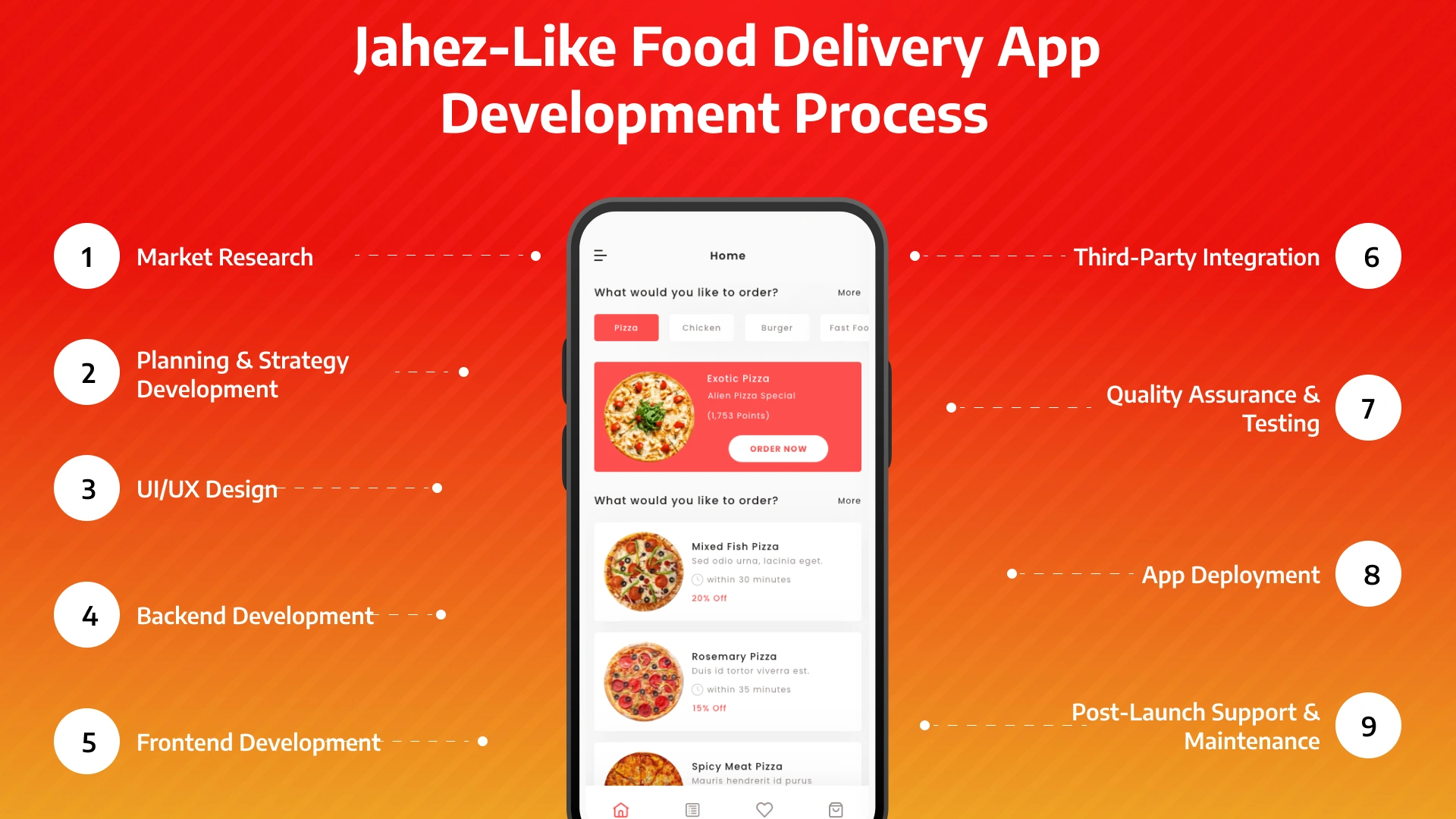
Market Research is the foundation of app development. It involves understanding user needs, studying competitors, analyzing market trends, and identifying gaps in existing solutions. This step ensures that the app concept aligns with user expectations and market demand, making it viable and competitive.
Planning & Strategy Development comes next, where the project’s scope, timeline, and budget are defined. Stakeholders determine the core features of the app, business model (such as commission-based or subscription), and monetization strategies. A well-documented roadmap and technology stack are also established during this phase.
UI/UX Designers create intuitive wireframes and engaging prototypes to ensure the app is easy to navigate. An aesthetically pleasing interface helps enhance user experience for both customers and delivery personnel.
In this stage, experienced backend developers build database, APIs, admin panel, and the system architecture needed to support functionalities like order tracking, restaurant management, and user authentication. Security, scalability, and performance are top priorities during this phase.
Frontend Development involves bringing the design to life. Skilled frontend developers code the client-facing side of the app, ensuring responsiveness and compatibility across devices and platforms (iOS, Android, Web). It includes features like search filters, menu browsing, order placement, and user profile management.
Third-party integration is essential for a food delivery app. This includes integrating payment gateways, real-time GPS tracking, SMS/Email notifications, and restaurant POS systems. Seamless integration ensures a smoother workflow and better user experience.
Quality Assurance & Testing ensures the app functions correctly under all scenarios. QA test automation engineers conduct rigorous testing, including functional, usability, performance, and security testing. Bugs and glitches are identified and resolved before the app goes live.
App Deployment involves publishing the app on Google Play Store and Apple App Store. Developers ensure compliance with platform guidelines and optimize the app for discoverability, including metadata and visuals.
Post-Launch Support & Maintenance is vital for long-term success. This includes monitoring performance, fixing post-launch issues, rolling out regular updates, and incorporating user feedback. Continuous support helps retain users and stay competitive in the ever-evolving food delivery industry.
Here’s a detailed estimated breakdown of the cost to build a food delivery app like Jahez:
| Development Stage | Estimated Cost (SAR) | Estimated Cost (USD) |
| Market Research | 18,750 – 37,500 | $5,000 – $10,000 |
| Planning & Strategy Development | 22,500 – 45,000 | $6,000 – $12,000 |
| UI/UX Design | 37,500 – 75,000 | $10,000 – $20,000 |
| Backend Development | 75,000 – 150,000 | $20,000 – $40,000 |
| Frontend Development | 56,250 – 112,500 | $15,000 – $30,000 |
| Third-Party Integration | 37,500 – 75,000 | $10,000 – $20,000 |
| Quality Assurance & Testing | 26,250 – 56,250 | $7,000 – $15,000 |
| App Deployment | 11,250 – 18,750 | $3,000 – $5,000 |
| Post-Launch Support & Maintenance* | 7,500 – 26,250/month | $2,000 – $7,000/month |
This estimate is for an MVP (Minimum Viable Product) version of an app similar to Jahez with essential features. Food delivery app development costs may rise significantly for advanced functionalities like AI-powered recommendations, fleet management systems, or multi-language support.
Build a Successful On-Demand Food Delivery App Like Jahez with VLink
Building a thriving food delivery app like Jahez in Saudi Arabia takes more than just technical skills—it requires a trusted partner with deep market understanding and a proven track record.
At VLink, we combine advanced technology with local market expertise to deliver scalable, high-performance mobile apps. As a custom app development company in Dubai, we offer transparent cost estimations and tailor-made solutions built on robust architectures.

Here are several reasons why you should choose VLink to build an app like Jahez in KSA:
- We go beyond basic app development by incorporating AI, IoT, and real-time analytics to create smarter, more efficient food delivery platforms.
- Our credibility is backed by work with global giants like Marico, where we've developed digital solutions that boost user engagement and streamline operations.
- We design apps that support the Arabic language and right-to-left (RTL) UI/UX for seamless local user experience.
- Our team ensures full compliance with Saudi data and payment regulations, including SAMA guidelines.
- We implement hyperlocal marketing strategies tailored to the Saudi market to drive user acquisition and retention.
Bonus Tip: Check out our case study to see how we helped a food manufacturing company modernize its digital platform.
When you choose VLink, you're not just hiring developers—you’re partnering with a team that understands the nuances of the Saudi market and is committed to delivering scalable, secure, and future-ready solutions.
Want to know the exact cost to develop a food delivery app like Jahez in Saudi Arabia? Contact VLink today for a personalized consultation.





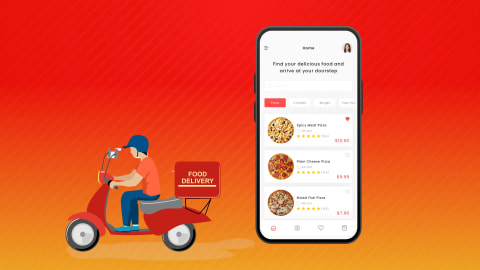


 Shivisha Patel
Shivisha Patel
















